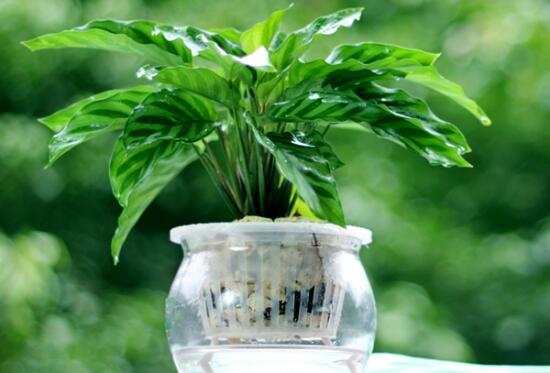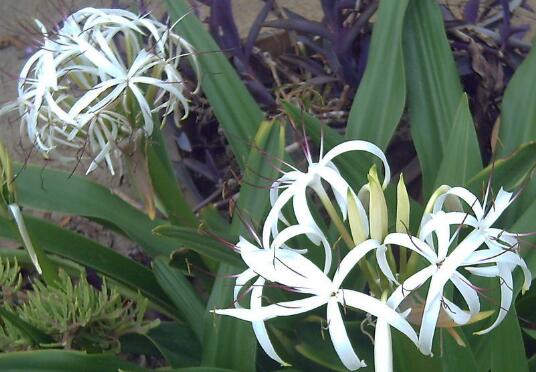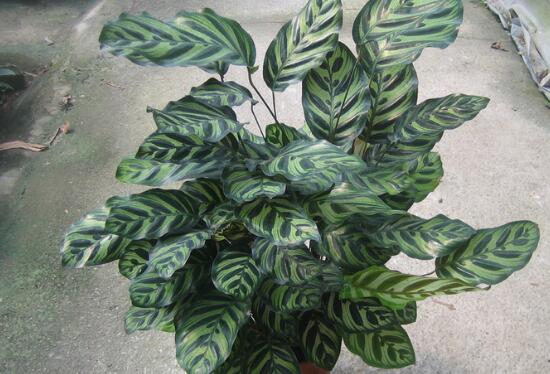Can peacock taro be cultured in water? the method of water culture of peacock taro / change water every 2 days
Beautiful things always make people miss them and make people think that they are more beautiful. So when you see the beauty of potted peacock arrowroot, many people begin to want to raise it in water, because compared to soil culture, hydroponic plants are obviously more beautiful, can peacock arrowroot be cultivated in water? According to the understanding of the growth habits of peacock arrowroot, it can be hydroponic, the following with the small series to see the hydroponic method of peacock arrowroot.
A: Can a peacock arrowroot be cultured? Yes.

Peacock arrowroot looks beautiful, especially the pattern on its leaves, looks like peacock open tail. The peacock arrowroot cultivated in soil is already so beautiful. If it is cultivated in water, it will be terrible. Can the peacock arrowroot be cultivated in water? Because peacock arrowroot likes wet environment, and the humidity required is high, so it can be cultured, and then go to see the specific method of hydroponic culture.
2. Cultivation method of arrowroot
Ingredients: a pot of peacock arrowroot, hydroponic container, potassium permanganate solution, clear water
1. Substrate selection
In fact, the cultivation of peacock arrowroot is not the whole water culture that everyone imagines, but also the combination of water and soil. Generally speaking, flower friends usually use pearlite: vermiculite 1:1 or pearlite: peat: slag 1:1 mixture as substrate.
2. Hydroponic plants
If you want to cultivate peacock arrowroot, you must first naturally have hydroponic plants. For this, you can choose small and healthy soil culture plants. It should be noted that the long peacock arrowroot should not be used, because the plant is too big, the hydroponic container should not be selected, and it is easy to lodge, not good maintenance.
3. Hydroponic method
① Take out the small soil-cultured peacock arrowroot, wash the soil at the root with root washing method, try not to leave soil; then soak the root with diluted potassium permanganate solution for about ten minutes, then wash it with clean water, and then plant it in a container, add clean water to 1/3-1/2 of the root of peacock arrowroot.
Peacock arrowroot this kind of hydroponic method, at the beginning of the leaves will have curly phenomenon, we do not panic, this is a normal phenomenon. At this time, just put it in a ventilated shady place, and properly spray the leaves, change the water every 1-2 days, and soon the leaves will return to normal, about 10 days later will grow new roots. After the plants adapt to the hydroponic environment, add nutrient solution and change it every 3-4 weeks.
2. There is also a method of using substrate for cultivating peacock arrowroot. As above, after taking out the soil-cultured peacock arrowroot, clean the root with clean water; then lay a layer of ceramsite on the bottom of the pot as a drainage layer, place the seedlings, add the prepared substrate until the pot is eight minutes full, compact with hands, and finally add a layer of ceramsite on the pot to prevent algae from growing and washing away the substrate or washing down the seedlings after sunlight.
Can peacock arrowroot be cultured in water? Peacock arrowroot culture method
A typical ornamental plant, resembling the pattern on the peacock tail feathers. Common peacock arrowroot is potted, can peacock arrowroot be cultured? What about the hydroponics method?
1. Can peacock arrowroot be cultured?
Peacock arrowroot originated in Brazil, like high temperature, high humidity and semi-overcast environment, not cold-resistant, like sufficient scattered light, avoid direct sunlight. Peacock arrowroot can be cultured, and cultured peacock arrowroot is more fresh and elegant, wonderful and exquisite, and loved by everyone.
Culture peacock arrowroot need to select healthy growth of small soil culture plants, with the root washing method will root soil clean, with very dilute potassium permanganate solution soak roots for about ten minutes, washed with water, and then planted in containers. Add water to 1/3-1/2 of the roots of peacock arrowroot.
The initial leaves of hydroponic culture have curling phenomenon, it is appropriate to place it in a ventilated shady place, and properly spray water on the leaves, change the water every 1-2 days, and soon the leaves will return to normal, and new roots will grow after about 10 days. When the plants are completely adapted to the hydroponic environment, they are maintained by adding nutrient solution of leaf observation plants, and the nutrient solution is replaced once every 3 to 4 weeks, and the lost water is only needed at ordinary times.
II. Cultivation method of arrowroot in water culture
The water culture of peacock arrowroot can be made of plastic pot or antique ceramic flowerpot, and the matrix can be mixed matrix of pearlite: vermiculite 1:1 or pearlite: peat: slag 1:1. A layer of ceramsite is laid on the bottom of the pot as a drainage layer when the pot is placed, then the seedlings are placed, the prepared substrate is added to the pot until the pot is eight minutes full, and the hand is compacted, and finally a layer of ceramsite is added on the pot to prevent algae from growing and washing away the substrate or washing down the seedlings after the sun is exposed.
Peacock arrowroot afraid of drying, in the dry season and summer high temperature period, to often spray water on the leaves. During winter heating, stay away from stoves, heaters or air conditioners. When necessary, cover plastic bags, often open water spray moisturizing, ventilation. Winter low temperature stage should reduce the number of rehydration, watering, surface substrate dry after watering, so as not to cause rotten roots and leaves.
Peacock arrowroot plants are most afraid of direct sunlight. Direct light will cause curly leaves and dry edges. Therefore, they should be placed indoors with bright scattered light all year round. Before heating in winter in northern China and for a period of time after heating is stopped, attention should be paid to cold protection and warmth. The room temperature should not be lower than 13℃, otherwise it is easy to suffer from cold damage and rotten roots and yellow leaves. Plastic bags can be used to protect plants and increase air humidity.
The nutrient solution can be selected from the above-mentioned foliage plant nutrient solution or compound flower fertilizer. The nutrient solution should be diluted 3-5 times for the first time and poured thoroughly at one time. until exudate is present in the tray. Rehydration 1-2 times a week on weekdays, 100 ml each time. Moisturize daily to keep the matrix moist. Do not replenish water on the day of rehydration, and do not store water in the basin bottom tray for a long time to facilitate ventilation and prevent root rot.
The above is the peacock arrowroot hydroponic cultivation method shared, like hydroponic cultivation friends can understand oh, I hope to help everyone.
Can peacock arrowroot be cultivated in water culture? The cultivation method of peacock arrowroot in water culture
Peacock arrowroot leaves colorful, beautiful plant type, charming temperament, so much loved by people. So can peacock arrowroot be cultured in water? The following is an introduction to the cultivation method of peacock arrowroot culture.
Can peacock arrowroot be cultured in water?
Peacock arrowroot can be cultured, and cultured peacock arrowroot is more fresh and elegant, wonderful and exquisite, and loved by everyone.
Culture method of arrowroot in water culture
Culture peacock arrowroot need to select healthy growth of small soil culture plants, with the root washing method will root soil clean, with very dilute potassium permanganate solution soak roots for about ten minutes, washed with water, and then planted in containers. Add water to 1/3-1/2 of the roots of peacock arrowroot.
The initial leaves of hydroponic culture have curling phenomenon, it is appropriate to place it in a ventilated shady place, and properly spray water on the leaves, change the water every 1-2 days, and soon the leaves will return to normal, and new roots will grow after about 10 days. When the plants are completely adapted to the hydroponic environment, they are maintained by adding nutrient solution of leaf observation plants, and the nutrient solution is replaced once every 3 to 4 weeks, and the lost water is only needed at ordinary times.
The water culture of peacock arrowroot can be made of plastic pot or antique ceramic flowerpot, and the matrix can be mixed matrix of pearlite: vermiculite 1:1 or pearlite: peat: slag 1:1. A layer of ceramsite is laid on the bottom of the pot as a drainage layer when the pot is placed, then the seedlings are placed, the prepared substrate is added to the pot until the pot is eight minutes full, and the hand is compacted, and finally a layer of ceramsite is added on the pot to prevent algae from growing and washing away the substrate or washing down the seedlings after the sun is exposed.
Peacock arrowroot afraid of drying, in the dry season and summer high temperature period, to often spray water on the leaves. During winter heating, stay away from stoves, heaters or air conditioners. When necessary, cover plastic bags, often open water spray moisturizing, ventilation. Winter low temperature stage should reduce the number of rehydration, watering, surface substrate dry after watering, so as not to cause rotten roots and leaves.
Peacock arrowroot plants are most afraid of direct sunlight. Direct light will cause curly leaves and dry edges. Therefore, they should be placed indoors with bright scattered light all year round. Before heating in winter in northern China and for a period of time after heating is stopped, attention should be paid to cold protection and warmth. The room temperature should not be lower than 13℃, otherwise it is easy to suffer from cold damage and rotten roots and yellow leaves. Plastic bags can be used to protect plants and increase air humidity.
The nutrient solution can be selected from the above-mentioned foliage plant nutrient solution or compound flower fertilizer. The nutrient solution should be diluted 3-5 times for the first time and poured thoroughly at one time. until exudate is present in the tray. Rehydration 1-2 times a week on weekdays, 100 ml each time. Moisturize daily to keep the matrix moist. Do not replenish water on the day of rehydration, and do not store water in the basin bottom tray for a long time to facilitate ventilation and prevent root rot.
- Prev

Can Manjusri be hydroponically cultivated? the method of hydroponics / changing water frequently / avoiding strong light
Wenshulan is a kind of highly ornamental flower plant, which can be seen in many parts of our country. It is usually planted in the way of soil culture, but some people want to try hydroponics, so can Manjusri be hydroponic? Actually, it can. So what is the method of Shui Pei Wen Shu Lan?
- Next

Is it easy to raise peacock taro? how to raise peacock taro in winter / clean leaves once a month
Beautiful peacock taro, flower friends should be no stranger, it is evergreen, with peacock open screen pattern of leaves, let people see a deep impression, then peacock taro easy to raise? It is understood that peacock taro likes a warm environment, so whether it is good or not depends mainly on winter. How to raise peacock taro in winter?
Related
- Fuxing push coffee new agricultural production and marketing class: lack of small-scale processing plants
- Jujube rice field leisure farm deep ploughing Yilan for five years to create a space for organic food and play
- Nongyu Farm-A trial of organic papaya for brave women with advanced technology
- Four points for attention in the prevention and control of diseases and insect pests of edible fungi
- How to add nutrient solution to Edible Fungi
- Is there any good way to control edible fungus mites?
- Open Inoculation Technology of Edible Fungi
- Is there any clever way to use fertilizer for edible fungus in winter?
- What agents are used to kill the pathogens of edible fungi in the mushroom shed?
- Rapid drying of Edible Fungi

